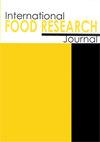壳聚糖和水杨酸防治蓝莓采后真菌病的研究
IF 1
4区 农林科学
Q4 FOOD SCIENCE & TECHNOLOGY
引用次数: 0
摘要
蓝莓(Vaccinium corymbosum)的特点使其成为寻求健康益处的人群非常垂涎的水果,从而具有经济和社会意义。然而,它是一种很容易腐烂的水果。本文从蓝莓中分离得到了葡萄孢菌、青霉菌和交替孢菌,并进行了分子鉴定。然后评价壳聚糖(CHI)和水杨酸(SA)对这些植物病原体生长的体外影响,以及这些处理在蓝莓上应用后的发病率。1.5%浓度的CHI对葡萄孢菌、青霉菌和交替孢菌的体外生长抑制率分别为93%、84%和40%。此外,青霉菌和互交菌的萌发被完全抑制;Botrytis sp.孢子对壳聚糖处理不敏感。与对照相比,在25°C贮藏期后收获的蓝莓中,体内施用1.5% CHI和5 mM SA降低了植物病原体的发芽率90%。综上所述,SA和CHI为蓝莓植物病原菌的防治提供了一种替代方法,以消除合成杀菌剂的使用。本文章由计算机程序翻译,如有差异,请以英文原文为准。
Chitosan and salicylic acid as alternatives for the control of postharvest fungal diseases in blueberries (Vaccinium corymbosum)
Blueberry (Vaccinium corymbosum) has characteristics that make it a highly coveted fruit by the population that seeks benefits for their health, thus giving it economic and social relevance. However, it is a very perishable fruit. In the present work, Botrytis sp., Penicillium sp., and Alternaria sp. were isolated from blueberry, and molecularly identified. The in vitro effect of chitosan (CHI) and salicylic acid (SA) on the growth of these phytopathogens was then evaluated, as well as the incidence of the disease after the application of these treatments on blueberry. CHI at 1.5% achieved an in vitro mycelial growth inhibition of Botrytis sp., Penicillium sp., and Alternaria sp. by 93, 84, and 40%, respectively. Furthermore, a complete germination inhibition of Penicillium sp. and Alternaria sp. was accomplished; Botrytis sp. spores were less sensitive to chitosan treatment. The germination percentage of the phytopathogens was reduced by 90% using SA at 5 mM. The in vivo application of CHI at 1.5% and SA at 5 mM decreased the percentage of incidence of phytopathogens in blueberries harvested after storage period at 25°C, as compared to the control. Based on these results, SA and CHI represent an alternative for the control of phytopathogens in blueberry to eliminate the use of synthetic fungicides.
求助全文
通过发布文献求助,成功后即可免费获取论文全文。
去求助
来源期刊

international food research journal
Agricultural and Biological Sciences-Food Science
CiteScore
1.40
自引率
0.00%
发文量
75
期刊介绍:
The International Food Research Journal (IFRJ) publishes papers in English, six (6) issues a year with the coverage of:
Food Science and Technology
Nutrition and Dietetics
Agriculture, multidisciplinary
Chemistry, multidisciplinary
The scope of the Journal includes:
Food Science, Food Technology and Food Biotechnology
Product Development and Sensory Evaluation
Food Habits, Nutrition, and Health
Food Safety and Quality
Food Chemistry, Food Microbiology, Food Analysis and Testing
Food Engineering
Food Packaging
Food Waste Management
Food Entrepreneur
Food Regulatory
Post-Harvest Food Management
Food Supply Chain Management
Halal Food and Management
 求助内容:
求助内容: 应助结果提醒方式:
应助结果提醒方式:


